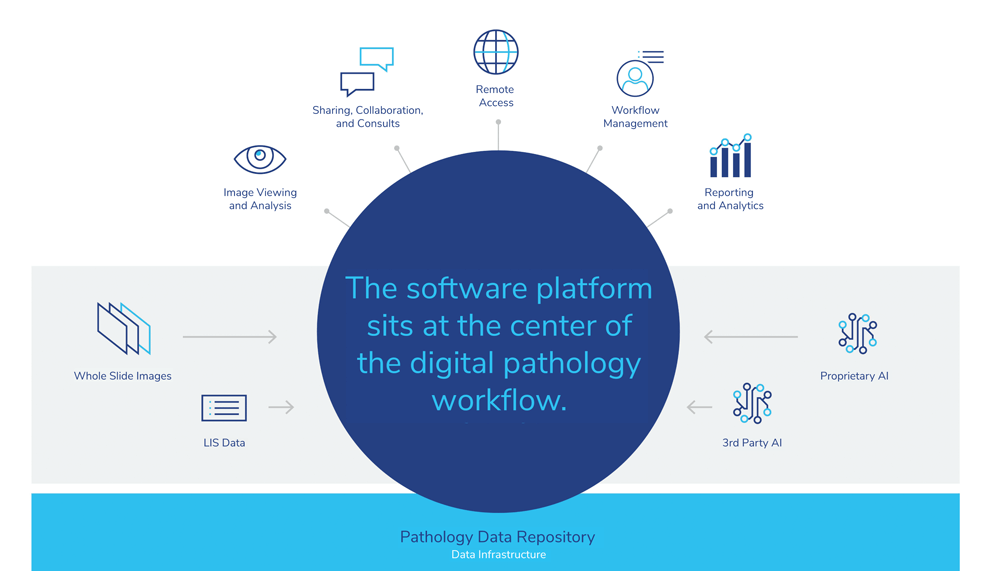
Here’s a trick question: how much are pathologists expected to know about IT?
Your immediate answer is probably along the lines of “not much.” After all, pathologists have primarily carried out their commitment to excellent patient care with the microscope for decades. Now, though, the rise of digital pathology is putting pathologists in a position where they need to understand the basics. Digital pathology is, in fact, technology that your laboratory will likely soon implement to realize clinical and economic gains. Although you can rest assured that your IT team will serve as trusted advisors in this effort, you – as the user – have the opportunity to collaborate closely with your technical colleagues to drive alignment, accelerate timelines, and ensure the project goes smoothly.
Just as you would begin your digital transformation by building a business case and identifying uses, you should also take the time to understand the key IT considerations that will affect your transition from microscope to image. With even a little understanding, you can be empowered to shape your laboratory’s digital future.
Performing at scale
One of the most important decisions you’ll make in the digitization journey is choosing your platform. This software sits at the center of your day-to-day operations, powering everything from image viewing to sharing and collaboration.
When evaluating platforms, you’ll likely be drawn to features and functionality at first. And that’s natural; you’ll want to understand how it will enhance your routine work. Your peers in IT, on the other hand, will probably prioritize scalability – and for good reason. Scalability has everything to do with how the solution will grow with your organization. If a platform isn’t scalable, it’s worth ruling out from the get-go.
How will your IT team assess scalability? They will ensure that the platform can support all your pathology images, which have massive file sizes, as well as your users and sites – both today and tomorrow. They will also assess user management, looking for robust roles and permissions to provide everyone with the right amount of access no matter the number of users. Scalability also encompasses security and compliance to address HIPAA and protected health information requirements.
Performance, a closely linked concept, is one that you’ll also want to grasp. When some platforms scale to support multiple sites, it comes at the expense of other important factors, such as image quality and load times. These solutions do not perform at scale – a key consideration if you want to implement digital pathology across an entire institution or organization.
Open to the future
There’s one final component of scalability so essential that it merits a discussion all its own, and that’s interoperability. “Interoperability” refers to the exchange of information – and, because it has made headlines in healthcare for years, it might be somewhat familiar.
With respect to digital pathology, interoperability comes into play when thinking about scaling the hardware and software ecosystem needed to power your operations – including your digital pathology platform, scanners, laboratory information system, and image analysis applications. If data cannot pass between these solutions, your team will be forced to waste precious time manually uploading scanned images and jumping from screen to screen.
To help guide your conversations with IT, it’s useful to understand how laboratories address the need for interoperability. Because the digital pathology platform sits at the center of day-to-day work, many organizations ensure that their platform is open in nature and integrates with any complementary hardware or software solution. This way, images automatically appear in the platform and pathologists can see all relevant case details and analysis results when making a diagnosis. An open platform also provides investment protection so that you can seamlessly deploy and scale new technologies, such as artificial intelligence, as your needs evolve.
Alternatively, some organizations opt for a closed system whereby a single vendor provides both scanner and platform. Although it may seem easier to get up and running with a closed system (because you rely on just one vendor for the two most critical components of your digital pathology ecosystem), these systems offer less flexibility when it comes to integrating other solutions.

Unclouding infrastructure selection
Infrastructure, which relates to where you house your applications and data, is an especially important IT consideration for digital pathology. Pathology images are massive – two to 10 times larger than the average radiology image. And that means they can be expensive to store and slow to access if the right infrastructure isn’t in place. Although your IT team will almost certainly have organization-wide policies that guide infrastructure selection, you should know that, at the highest level, there are two different options: on-premises and cloud.
With an on-premises model, all data lives within your organization on servers managed by your IT team. For this reason, on-premises infrastructure typically delivers better performance for image viewing. It provides your IT team with more control, which can be ideal given the need to keep sensitive patient information secure. The main drawback is that on-premises infrastructure comes with a bigger upfront capital investment and requires more resources to maintain.
Data stored in the cloud is hosted in an off-site location. This location can be public, shared among organizations with data hidden, or private. Public clouds are managed by well-known providers, so they present less work for your IT team and offer instant scalability. And, because resources are shared, they can be more affordable. Private clouds, on the other hand, can be managed by third parties or by your IT team. Like on-premises infrastructure, they give you more control, but come at a higher cost.
Because there are pros and cons to each of these options, some organizations choose to go with a hybrid model where they mix infrastructure to best suit their needs. These organizations might keep some data on-premises for quick access and send archival data to the cloud where it can reside at a lower cost.
The rapid acceleration of digital pathology adoption means that every pathologist is quickly turning into an information technologist. By establishing a basic understanding of the key considerations you’ll need in this new role, you can collaborate closely with your IT team to grow your knowledge and increasingly ensure that your laboratory is prepared to capitalize on the benefits that lie ahead.




